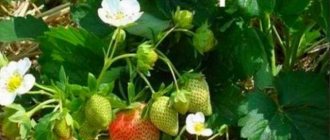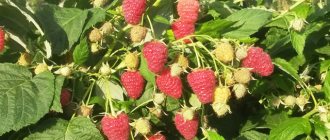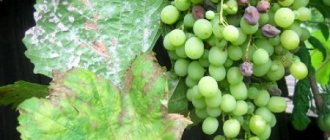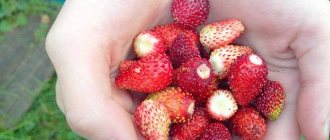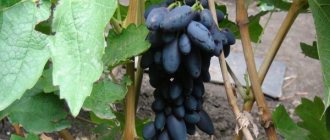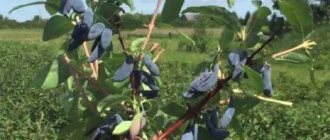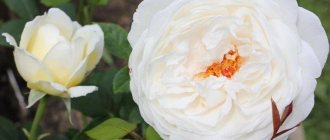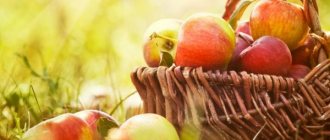Description of the variety and photo
The “Florina” variety is the result of the work of Dutch breeders; it was bred not so long ago, but has already acquired its connoisseurs. Strawberries "Florina" are universal - they are tasty both fresh and processed, they are easy to freeze, and the berry can easily be transported.
The bush is compact, medium in size, densely covered with large leaves of light green color. It is distinguished by powerful, straight-growing peduncles and medium arborescence.
The advantages of the variety can safely be attributed to:
- resistance to climate change - “Florina” is able to withstand both frost and drought;
- ability to adapt in open ground and in greenhouses, as well as in city apartments - successfully grown in pots and containers;
- large fruit and high yield;
- long period of fruiting - until the last months of autumn.
Peculiarity! The secret to the attractiveness of this variety is the large size of the berries and their special taste.
Description and characteristics of strawberries of the Florina variety
The Florina variety is early, productive, and produces 1 kg of berries per bush. Belongs to the Dutch selection. The variety is remontant, blooms consistently from May to October, and produces berries for a long time. Ripe fruits weigh 35-40 g, round-conical, shiny. The berries are sweet and have a characteristic smell. The pulp of Florin strawberry fruits is dense, pink, and the skin is red. Suitable for transportation, storage and freezing.
The bushes are medium-sized, compact, with an average mass of leaves. The peduncles are tall, rising above the leaves, the leaves are green. Florina strawberries do not tolerate thickening well, but are resistant to disease and cold.
Characteristics of the berry
“Florina” berries pleasantly surprise with their considerable size and impressive weight for strawberries - from 40 to 80 grams each. The shape of the fruit is conical (cone-shaped), the structure of the pulp is dense, the color is bright, scarlet and red.
The berries have a unique taste; experts characterize it as sweet with a slight sourness, very delicate and subtle. The real, pronounced strawberry aroma is also attractive. The fruits have a glossy shine.
The peculiarity of the variety is that the berries of each new harvest do not become smaller than the first fruits. And this is the difference from most large-fruited species.
It begins to bear fruit at the same time as other early-ripening species, and the formation of berries is completed only in late autumn.
a brief description of
Advantages of the variety
The main advantages of Florina strawberries are the size and taste of the fruit. In addition, among the advantages it is worth highlighting the following:
- good winter hardiness;
- tolerance to spotting and mites;
- long fruiting period;
- high productivity;
- early ripening;
- Harmonious ripening, most berries have an excellent presentation.
Disadvantages of the variety
Some gardeners consider insufficient sugar content to be a disadvantage - the presence of sourness in the taste. However, this is a matter of taste preference. In addition, there are obvious disadvantages:
- low fruit density;
- high demands on soil (often chlorositis);
- loss of bushes in extreme heat.
To combat raspberry chlorosis, the drugs Brexil and Micom are often used.
Reproduction
"Florina", like other types of remontant strawberries, can be propagated by mustaches:
- The most developed annual bushes are selected, their strongest tendrils are laid out along specially made grooves along the beds.
- The remaining mustaches are cut off, otherwise they will weaken the bush.
- When rosettes appear, you need to leave only the first ones, those closest to the mother bush. After roots appear on them, the shoots are slightly buried in the ground.
- To ensure that they quickly gain strength, they are regularly watered and the soil around them is loosened.
- It should be separated from the mother plant 7-10 days before replanting into a new bed. In this way, young seedlings are given the opportunity to grow stronger.
- After this, the seedlings are planted in a new permanent habitat.
There is another way to propagate strawberries - by dividing the bush. Strong, well-developed plants that are already 2 to 4 years old are suitable for this. They have a strong root system with numerous shoots (horns).
The selected bush must be dug up, divided into horns and each planted in a garden bed. In this way, “Florina” can be propagated in both spring and autumn.
Landing Features
Strawberries of the hybrid form "Florian F1" need good lighting and sufficient moisture in the planting area. It can be grown by both seed and seedling methods.
Sowing of stratified seed material is carried out around February-March - superficially, in well-moistened fertile soil. Then the seedling container is covered and until the strawberry shoots appear, the soil moisture is monitored, periodically spraying it with warm water from a spray bottle. After 2-3 true leaves appear on the seedlings, the seedlings are planted into separate planting containers.
Strawberry seedlings are planted on ridges in open ground in the spring, after the threat of return frosts has passed.
The area for growing garden strawberries should be level, cleared of weeds, without significant shading or waterlogging, with loose, well-aerated and fertile soil with neutral acidity.
When planting, the distance between rows should be 25-30 cm, and between strawberry bushes - at least 15 cm. It is important to control the depth of the plant’s immersion in the soil: you cannot bury the “heart”, but placing it too high is undesirable, because can cause the plant to dry out and die.
Landing
For planting, high-quality seedling material grown in specialized nurseries is best suited.
To achieve a good strawberry harvest, the gardener needs to follow important rules:
- carefully select the site for planting. You cannot plant a berry crop where nightshades grew before. For good growth, soil in which onions, garlic, mustard, various root vegetables and legumes were grown is suitable;
- for “Florina”, an area with good lighting, medium and low acidity, not swampy, preferably with loamy or sandy loam soil is suitable;
- Seedlings should be planted in cloudy weather or in the evening hours when there is no sunlight;
- Before planting, keep the bushes cool and in moist soil for several days;
- when planting seedlings in a hole, you should carefully straighten the roots, placing the heart of the rosette at soil level;
- after planting, the plants are watered with warm water and the beds are mulched;
- Strawberries are planted in two ways: one-line and two-line. The distance between the bushes depends on this - it can vary from 15-20 to 30-40 cm.
Important! Only healthy seedlings can produce a good harvest in the future. When purchasing, you should make sure that the seedling has no diseases, pay attention to its root system, appearance and number of leaves.
Watering
"Florina", like other remontant varieties, needs more frequent watering than regular strawberries:
- Newly planted seedlings need to be watered daily (the first 4-5 days), then watering is done every other day; already established seedlings need no more than once a week.
- Strawberry bushes planted last year are watered for the first time in the new season at the end of April. And from May to September, watering is carried out twice a month.
- If the summer is dry and there is no rain, then the soil should be moistened more often, as needed, so that the soil does not dry out.
- The water should be warm. It is better to take rainwater, which is gradually collected in a barrel in advance.
- Morning and evening are the optimal times.
- To retain moisture in the soil, loosening or mulching is necessary. Mulch can be sawdust, spruce or pine needles, straw, hay, humus.
Reference! In addition to conserving moisture, the benefit of mulching is that it prevents the growth of weeds. Spunbond can be used as a protective coating.
Care and feeding
Full care of strawberries of the “Florina” variety implies an integrated approach - from preparing the site for planting in the spring to autumn disease prevention and covering the bushes to protect them from frost.
In the process of growing a garden crop, it needs to be watered, fertilized, mulched, loosened the soil, removed weeds, controlled pests and carried out regular fertilizing:
- Phosphorus is added only before planting - from 15 to 20 g of superphosphate is taken for each m². But strawberries need to be provided with potassium and nitrogen regularly.
- Towards the end of May, strawberries should be fed with a weak urea solution. Starting from mid-June, the bushes are watered with slurry or diluted chicken droppings (up to 10 buckets of water are required per bucket of fertilizer).
- In addition to organic matter, mineral fertilizers are used, such as Kemira Lux, Mortar, Crystallin.
- Fertilizers must be applied at the root of the bush. During the season you will need at least 10 complex feedings.
- Strawberry bushes are also fed with nutritious herbal mixtures and nettle infusion.
- It is necessary to fertilize throughout the entire growing season, before the onset of autumn, so that the garden crop does not weaken from constant fruiting. In autumn - rotted manure.
- Potassium sulfate, ash diluted in water, and ammonium nitrate are used as fertilizers. On average, up to 10 liters of solution are needed per 1 m² - this applies to both mineral and organic fertilizers.
An important step is preparing the crop for winter. Be sure to carry out the pruning procedure - remove the mustache, damaged and diseased leaves. In autumn, preventive treatment of crops against diseases and pests is carried out.
The old mulch is removed and new mulch is laid down. In colder regions, plants are covered for the winter with a layer of straw up to 8 cm thick, and then spruce branches are placed on top.
Description of the berry crop
The sources indicate this variety under consonant names: “arosa” and “arosa”. It was obtained in Italy and is the result of crossing Chandler and marmalade. Strawberries inherited the best characteristics from their ancestors.
Brief description of the variety: bright taste, extended fruiting period and resistance to fungal and viral infections.
The strawberry variety "Arosa" has the following characteristics:
- bushes of medium size, spreading leaves, light green, with pubescence along their edges and on the petioles;
- development is rapid;
- peduncles rise above the foliage, the inflorescences themselves are presented in the shape of a cup with a corolla;
- the intensity of whisker formation is average, they are enough for reproduction, but the grooming process is not burdened by their removal;
- the fruits are orange-red, shiny, round in shape (this can be seen in the photo), tiny seeds are noticeable on the surface;
- on average, the weight of the berry reaches 30-45 g;
- the first fruits are represented by a scallop (usually they are round).
Due to the fact that "arosa" ripens a little later than other varieties, it is often grown for commercial purposes. The culture meets the basic requirements, it is not watery, can be easily transported and can be stored for a long time. The main indicators are visible in the photo.
Interesting! At the stage of technical maturity, the tips of the berries are uncolored and white.
Diseases and pests
Of the many diseases to which remontant strawberries are susceptible, it is worth noting the most common:
- Powdery mildew is a disease that affects the leaves of the plant. Sick bushes are destroyed, and healthy plantings are treated with a solution of potassium permanganate. One way to combat the disease is to spray crops with an emulsion of water, copper sulfate, soap and azocene. Treatment is carried out before flowering and after harvesting.
- Brown spot – leaves suffer from a disease caused by a fungus. For treatment, a 1% solution of Bordeaux mixture or copper chloride is used. Preventive measures include treating plantings with fungicides, killing weeds and thinning crops.
- Gray mold is a fungal disease that often occurs in cool, damp weather. Specks appear on the berries, then the fruits begin to dry. Diseased plants must be destroyed. To prevent the development of gray rot, it is necessary to observe crop rotation, destroy weeds, and mulch the soil during fruit ripening. Before the start of the growing season, the bushes should be treated with Bordeaux mixture.
Attention! Strawberries "Florina", unlike other varieties, suffer much less from gray rot. This is a definite plus, given the degree to which garden crops are affected by this disease.
Strawberries can be favored by various pests that cause a lot of trouble for gardeners:
- Most often, plants suffer from aphid attacks. The most environmentally friendly method of its destruction is considered to be spraying the bushes with garlic infusion. The plant is also watered with a mixture of laundry soap and wood ash.
- Strawberry and spider mites are dangerous pests. Because of them, the leaves curl and the bush itself slows down its growth. To destroy mites, the strawberry plantation must be treated with karbofos or phosphamide. This is done during the period of growth of young leaves. If there are a lot of pests, you can treat the bushes again just before flowering.
- Nematodes - these small worms are difficult to detect, their size is no more than 1 mm. They multiply quickly, affecting the bush, which becomes deformed and brittle, and almost no berries are formed. To combat the nematode, folk remedies are used - treatment with infusions of calendula, marigold, nasturtium, and onion. Chemicals that work effectively are Phosfamtide and Heterophos.
- Ants, although beneficial insects, are not welcome guests in strawberry beds. Bait traps containing poison are recognized as the best way to get rid of them.
- Wasps are frequent visitors to strawberry plantations. The way to combat them is simple - jars of sweet compote are placed along the beds.
In addition, Florina strawberries must be protected from the harmful effects of slugs, weevils, chafers, and leaf beetles.
Strawberry Florina: description of the dimensional variety, video review of the gardener about growing with photos
Each variety of strawberry has its own characteristics and advantages. Among this abundance, the remontant “Florina” stands out favorably with its productivity, climate resistance and pleasant taste of large berries.
Description of the variety and photo
The “Florina” variety is the result of the work of Dutch breeders; it was bred not so long ago, but has already acquired its connoisseurs. Strawberries "Florina" are universal - they are tasty both fresh and processed, they are easy to freeze, and the berry can easily be transported.
The bush is compact, medium in size, densely covered with large leaves of light green color. It is distinguished by powerful, straight-growing peduncles and medium arborescence.
The advantages of the variety can safely be attributed to:
- resistance to climate change - “Florina” is able to withstand both frost and drought;
- ability to adapt in open ground and in greenhouses, as well as in city apartments - successfully grown in pots and containers;
- large fruit and high yield;
- long period of fruiting - until the last months of autumn.
Peculiarity! The secret to the attractiveness of this variety is the large size of the berries and their special taste.
“Florina” berries pleasantly surprise with their considerable size and impressive weight for strawberries - from 40 to 80 grams each. The shape of the fruit is conical (cone-shaped), the structure of the pulp is dense, the color is bright, scarlet and red.
The berries have a unique taste; experts characterize it as sweet with a slight sourness, very delicate and subtle. The real, pronounced strawberry aroma is also attractive. The fruits have a glossy shine.
The peculiarity of the variety is that the berries of each new harvest do not become smaller than the first fruits. And this is the difference from most large-fruited species.
It begins to bear fruit at the same time as other early-ripening species, and the formation of berries is completed only in late autumn.
Reproduction
"Florina", like other types of remontant strawberries, can be propagated by mustaches:
- The most developed annual bushes are selected, their strongest tendrils are laid out along specially made grooves along the beds.
- The remaining mustaches are cut off, otherwise they will weaken the bush.
- When rosettes appear, you need to leave only the first ones, those closest to the mother bush. After roots appear on them, the shoots are slightly buried in the ground.
- To ensure that they quickly gain strength, they are regularly watered and the soil around them is loosened.
- It should be separated from the mother plant 7-10 days before replanting into a new bed. In this way, young seedlings are given the opportunity to grow stronger.
- After this, the seedlings are planted in a new permanent habitat.
There is another way to propagate strawberries - by dividing the bush. Strong, well-developed plants that are already 2 to 4 years old are suitable for this. They have a strong root system with numerous shoots (horns).
The selected bush must be dug up, divided into horns and each planted in a garden bed. In this way, “Florina” can be propagated in both spring and autumn.
Landing
For planting, high-quality seedling material grown in specialized nurseries is best suited.
To achieve a good strawberry harvest, the gardener needs to follow important rules:
- carefully select the site for planting. You cannot plant a berry crop where nightshades grew before. For good growth, soil in which onions, garlic, mustard, various root vegetables and legumes were grown is suitable;
- for “Florina”, an area with good lighting, medium and low acidity, not swampy, preferably with loamy or sandy loam soil is suitable;
- Seedlings should be planted in cloudy weather or in the evening hours when there is no sunlight;
- Before planting, keep the bushes cool and in moist soil for several days;
- when planting seedlings in a hole, you should carefully straighten the roots, placing the heart of the rosette at soil level;
- after planting, the plants are watered with warm water and the beds are mulched;
- Strawberries are planted in two ways: one-line and two-line. The distance between the bushes depends on this - it can vary from 15-20 to 30-40 cm.
Important! Only healthy seedlings can produce a good harvest in the future. When purchasing, you should make sure that the seedling has no diseases, pay attention to its root system, appearance and number of leaves.
"Florina", like other remontant varieties, needs more frequent watering than regular strawberries:
- Newly planted seedlings need to be watered daily (the first 4-5 days), then watering is done every other day; already established seedlings need no more than once a week.
- Strawberry bushes planted last year are watered for the first time in the new season at the end of April. And from May to September, watering is carried out twice a month.
- If the summer is dry and there is no rain, then the soil should be moistened more often, as needed, so that the soil does not dry out.
- The water should be warm. It is better to take rainwater, which is gradually collected in a barrel in advance.
- Morning and evening are the optimal times.
- To retain moisture in the soil, loosening or mulching is necessary. Mulch can be sawdust, spruce or pine needles, straw, hay, humus.
Reference! In addition to conserving moisture, the benefit of mulching is that it prevents the growth of weeds. Spunbond can be used as a protective coating.
Full care of strawberries of the “Florina” variety implies an integrated approach - from preparing the site for planting in the spring to autumn disease prevention and covering the bushes to protect them from frost.
In the process of growing a garden crop, it needs to be watered, fertilized, mulched, loosened the soil, removed weeds, controlled pests and carried out regular fertilizing:
- Phosphorus is added only before planting - from 15 to 20 g of superphosphate is taken for each m². But strawberries need to be provided with potassium and nitrogen regularly.
- Towards the end of May, strawberries should be fed with a weak urea solution. Starting from mid-June, the bushes are watered with slurry or diluted chicken droppings (up to 10 buckets of water are required per bucket of fertilizer).
- In addition to organic matter, mineral fertilizers are used, such as Kemira Lux, Mortar, Crystallin.
- Fertilizers must be applied at the root of the bush. During the season you will need at least 10 complex feedings.
- Strawberry bushes are also fed with nutritious herbal mixtures and nettle infusion.
- It is necessary to fertilize throughout the entire growing season, before the onset of autumn, so that the garden crop does not weaken from constant fruiting. In autumn - rotted manure.
- Potassium sulfate, ash diluted in water, and ammonium nitrate are used as fertilizers. On average, up to 10 liters of solution are needed per 1 m² - this applies to both mineral and organic fertilizers.
An important step is preparing the crop for winter. Be sure to carry out the pruning procedure - remove the mustache, damaged and diseased leaves. In autumn, preventive treatment of crops against diseases and pests is carried out.
The old mulch is removed and new mulch is laid down. In colder regions, plants are covered for the winter with a layer of straw up to 8 cm thick, and then spruce branches are placed on top.
Diseases and pests
Of the many diseases to which remontant strawberries are susceptible, it is worth noting the most common:
- Powdery mildew is a disease that affects the leaves of the plant. Sick bushes are destroyed, and healthy plantings are treated with a solution of potassium permanganate. One way to combat the disease is to spray crops with an emulsion of water, copper sulfate, soap and azocene. Treatment is carried out before flowering and after harvesting.
- Brown spot – leaves suffer from a disease caused by a fungus. For treatment, a 1% solution of Bordeaux mixture or copper chloride is used. Preventive measures include treating plantings with fungicides, killing weeds and thinning crops.
- Gray mold is a fungal disease that often occurs in cool, damp weather. Specks appear on the berries, then the fruits begin to dry. Diseased plants must be destroyed. To prevent the development of gray rot, it is necessary to observe crop rotation, destroy weeds, and mulch the soil during fruit ripening. Before the start of the growing season, the bushes should be treated with Bordeaux mixture.
Attention! Strawberries "Florina", unlike other varieties, suffer much less from gray rot. This is a definite plus, given the degree to which garden crops are affected by this disease.
Strawberries can be favored by various pests that cause a lot of trouble for gardeners:
- Most often, plants suffer from aphid attacks. The most environmentally friendly method of its destruction is considered to be spraying the bushes with garlic infusion. The plant is also watered with a mixture of laundry soap and wood ash.
- Strawberry and spider mites are dangerous pests. Because of them, the leaves curl and the bush itself slows down its growth. To destroy mites, the strawberry plantation must be treated with karbofos or phosphamide. This is done during the period of growth of young leaves. If there are a lot of pests, you can treat the bushes again just before flowering.
- Nematodes - these small worms are difficult to detect, their size is no more than 1 mm. They multiply quickly, affecting the bush, which becomes deformed and brittle, and almost no berries are formed. To combat the nematode, folk remedies are used - treatment with infusions of calendula, marigold, nasturtium, and onion. Chemicals that work effectively are Phosphamtide, Ruskamin, Heterophos.
- Ants, although beneficial insects, are not welcome guests in strawberry beds. Bait traps containing poison are recognized as the best way to get rid of them.
- Wasps are frequent visitors to strawberry plantations. The way to combat them is simple - jars of sweet compote are placed along the beds.
In addition, Florina strawberries must be protected from the harmful effects of slugs, weevils, chafers, and leaf beetles.
Reviews from gardeners
Most gardeners characterize Florina positively, noting its unpretentiousness, resistance to disease, and good berry yields:
- The variety is also attractive because it is suitable for growing in a greenhouse, container, or flowerpot. Strawberries actively bear fruit in open and closed ground conditions;
- the advantage, according to connoisseurs of this variety, is that it can be grown on different types of soil, but not forgetting that the yield still depends on how fertile the land is for planting the crop;
- experts recommend cultivating “Florina” in areas where the soil has a light to medium composition and neutral acidity;
- Opinions differ regarding the taste of this strawberry - not everyone likes the inherent slight sourness, but many are attracted by this zest of the variety.
Those who have tried to cultivate “Florina” appreciated its advantages and recommend the variety to their colleagues. At least two harvests of large, tasty berries a year - why not try growing such strawberries on your own plot?
Video
Video about one of the popular varieties of strawberries.
ufermer.com
Reviews from gardeners
Most gardeners characterize Florina positively, noting its unpretentiousness, resistance to disease, and good berry yields:
- The variety is also attractive because it is suitable for growing in a greenhouse, container, or flowerpot. Strawberries actively bear fruit in open and closed ground conditions;
- the advantage, according to connoisseurs of this variety, is that it can be grown on different types of soil, but not forgetting that the yield still depends on how fertile the land is for planting the crop;
- experts recommend cultivating “Florina” in areas where the soil has a light to medium composition and neutral acidity;
- Opinions differ regarding the taste of this strawberry - not everyone likes the inherent slight sourness, but many are attracted by this zest of the variety.
Those who have tried to cultivate “Florina” appreciated its advantages and recommend the variety to their colleagues. At least two harvests of large, tasty berries a year - why not try growing such strawberries on your own plot?
Characteristics of the variety
The bush is quite tall, powerful, densely covered with leaves. Due to their splendor, the bushes have a spherical shape.
The plant produces quite a lot of tendrils. As strawberries age, the plant form decreases significantly.
The leaves are large, dark green. Quite a lot of flowers are formed. The peduncles are long, strong, located above the level of the leaves, but despite this, they still fall to the ground under the weight of the fruit.
The berries of the British woman are large, wide-conical in shape. The shell is red when fully ripe and acquires a dark burgundy hue. There are yellow seeds on the surface of the shell.
The pulp is red, dense in structure, but not hard and does not crunch when biting the berry. The pulp is very juicy and has a pleasant, pronounced strawberry aroma.
The taste of Florence's strawberries is excellent. The berries are sweet, but not too much. There is a hint of sourness, but it only complements the flavor palette. One of the main advantages of this variety is that, despite the weather conditions, be it a rainy season or a too hot season, the berries still remain aromatic and tasty.
Berries have a universal purpose. They are suitable for fresh consumption, for processing (jam, jam, compote) and even for freezing.
Florence fruits are medium sized. Typically, the weight of a mature fruit is 30-40 grams. There are specimens of 50-60 grams, but most often when grown on an industrial scale.
The yield of British strawberries is high. From 1 plant you can easily collect up to 1 kg of marketable products, of course, if the growing conditions are suitable for the strawberries. At home, usually about 0.5-0.7 kg is collected from 1 bush.
As for the ripening period, these are late-ripening strawberries. On average, the ripening period for berries is early to mid-July.

